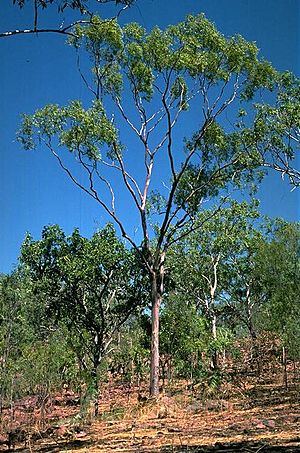Scarp gum facts for kids
Quick facts for kids Scarp gum |
|
|---|---|
 |
|
| Corymbia kombolgiensis | |
| Scientific classification | |
| Genus: |
Corymbia
|
| Species: |
kombolgiensis
|
| Synonyms | |
|
Eucalyptus kombolgiensis Brooker & Dunlop |
|
The Corymbia kombolgiensis, also known as the scarp gum or the paper-fruited bloodwood, is a type of small tree. It is found only in the Northern Territory of Australia. This tree usually has smooth bark. Sometimes, the bark near its base can be rough and look like a checkerboard. Its adult leaves are long and narrow, shaped like a spear. The tree produces white flowers, and its fruit looks like a small barrel.
Contents
What the Scarp Gum Looks Like
The scarp gum is a tree that typically grows up to 12 m (39 ft) tall. It has a special woody swelling at its base called a lignotuber. This helps the tree regrow after fires.
Bark and Leaves
The bark of the scarp gum is usually smooth. It can be creamy white to brownish in color. Sometimes, the lower part of the trunk has rough, grey bark that looks like small blocks fitted together.
Young scarp gum plants have leaves shaped like an egg or an oval. These leaves are about 45 mm (1.8 in) to 90 mm (3.5 in) long and 20 mm (0.79 in) to 60 mm (2.4 in) wide. They grow on a short stalk called a petiole.
Adult leaves are a slightly shiny green on both sides. They are long and narrow, like a spear, measuring 80 mm (3.1 in) to 210 mm (8.3 in) long and 6 mm (0.24 in) to 10 mm (0.39 in) wide. They also have a petiole, which is 4 mm (0.16 in) to 16 mm (0.63 in) long.
Flowers and Fruit
The flower buds of the scarp gum usually grow in groups where the leaves meet the stem. These groups are on a branched stalk up to 10 mm (0.39 in) long. Each branch of this stalk usually has seven buds, but sometimes up to thirteen. Each bud sits on its own small stalk, 5 mm (0.20 in) to 15 mm (0.59 in) long.
The mature buds are smooth and shiny. They are oval to pear-shaped, about 4 mm (0.16 in) to 6 mm (0.24 in) long and 3 mm (0.12 in) to 5 mm (0.20 in) wide. Each bud has a rounded cap on top. Scarp gums have been seen flowering in August, October, and November. Their flowers are white.
The fruit of the scarp gum is woody and shaped like a cylinder or a barrel. It is about 8 mm (0.31 in) to 10 mm (0.39 in) long and 4 mm (0.16 in) to 8 mm (0.31 in) wide. The fruit has thin walls, and the parts that open to release seeds are hidden inside.
Tree's Name and History
The scarp gum was first officially described in 1978. Two scientists, Ian Brooker and Clyde Dunlop, gave it the name Eucalyptus kombolgiensis. They found the first samples of this tree on Mount Brockman in Kakadu National Park in 1977.
Later, in 1995, two other scientists, Ken Hill and Lawrie Johnson, changed its name to Corymbia kombolgiensis. The second part of its name, kombolgiensis, comes from the Kombolgie sandstone. This is a type of rock formation where the scarp gum often grows.
Where the Scarp Gum Lives
The Corymbia kombolgiensis tree grows in open forests. You can find it on sandstone cliffs and flat areas called plateaus. Its home stretches from Pine Creek to the Arnhem Land plateau in the Northern Territory.

